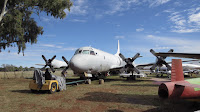 |
| In the cockpit on the Convair |
First up this morning, we went the Parkes Aviation Museum and this proved to be a surprise. I've been to a few of these, including the wonderful collection in Darwin, with its B-52 and Spitfire and F-111 ... and the list goes on. Parkes is organised by a group of volunteer, who not only share a love of aircraft but also a love of tinkering and fixing. For a minimum charge, you are introduced to the hulks of a Wessex helicopter, a Huey Cobra attack helicopter and Lockheed Electra - the same type of aircraft that Emlia Earhart was flying when she was lost to the world. There's also a cutdown Convair, which like many of the part aircraft on display in the hangar, has been opened up an full access is provided. I even sat in the pilot's seat! All this is rather good for the enthusiast but these are clearly old planes.
 |
| The Orion |
It still seems a complete aircraft and yet here you are, walking through it, able to sit in all but the pilots' seats and touch every dial.
Tucked away behind is another Neptune, out of the reach of the public and with half a dozen eager volunteer working on it.
Very high on the wow factory.
We returned to the front desk and had a chat to the two old fellas collecting money and as we could have predicted, they had stories to tell.
Leaving the airport, the GPS took us via an alternate route to the Parkes radio telescope. For alternate read from the opposite direction and for the last six or seven kilometres, over a dirt road that included the sign "Weather Only". We got there.
Its an imposing beast is the telescope and when we arrived, it was maneuvering into a new position. Having visted her at least three times, I've never seen it on the move. Inside, the displays were interesting and the theatre show featured a 3D presentation of things to do with Space and radio telescopes. There is a static display which explains the role of the Dish in telecasting the Apollo XI moonwalk. There was also an explanation of the factual liberties the movie The Dish (2000) took.We had a late morning tea at an underwhelming cafe and then soaked up all the information available and took lots of photos. The wind had picked up and for a long while the Dish was parked in its straight up position to protect it from the wind when it exceeds 35km/hr. Built in 1961, it has been the model for many other dishes and array which NASA has built. There is an amazing 1,000 tonnes in the moving part above the control tower and its accuracy is astounding. When pointed at an object in space, its accuracy is the quivalent of the width of a finger seen 150km away. It is a hard working piece of equipment, working on 24 hours a day and is observing the cosmos about 85% of the time. A further 5% is lost to high winds and there is about 10% down time scheduled to maintenance and testing.
Years ago, when the children were young, we did a tour of the tower below the dish - not the control room - but no such tours take place now. No doubt security is the major issue. |
| Click here for today's photos |
Another day in Parkes tomorrow in the last stages of this two week two.

No comments:
Post a Comment
All comments will be moderated before being posted.